South African Air Force Chronograph Lemania 5012

The South African Air Force (SAAF) is the air warfare branch of the South African National Defence Force , based in Pretoria .
The SAAF was established on 1 February 1920 and is one of the oldest surviving air forces.
The SAAF issued wristwatches to its pilots from the 1940s until the late 1980s, but subsequently stopped doing so due to budgetary constraints.
Issued between 1966 and 1987, the watches were not only worn during flights but are also associated with the large-scale and heated operations carried out by Cuban forces against the growing Soviet threat, which provided support to neighbouring Communist countries.
In the 1940s and 1950s, watches from LeCoultre and IWC were the first to be issued.
Lemania became a leading manufacturer for nearly 30 years, from the late 1960s to the late 1980s, with the Lemania Monopusher 2220, Lemania 1872, and Lemania 5012.
Then, ultra-modern, high-tech Seiko watches came to the forefront.
This is the second in a series that will cover all three Lemania military watches purchased by the SAAF (South African Air Force). This follows on from our previous article on the Lemania 1872.
The Lemania 5012 (Lemania Cal. 5012) was first issued to the SAAF almost 40 years ago.
2020 marks the SAAF’s 100th anniversary, so it’s fitting timing to feature SAAF and Lemania military watches.
The Lemania 5012 is a purely military watch made exclusively for the SAAF and RAN (Royal Australian Navy), with slightly different configurations and movements for the SAAF and RAN .
No production version of the Lemania 5012 was made.
origin

Lemania 5012 Prototype

SAAF final configuration (AF 12178)
According to experts, five prototypes of the Lemania 5012 were presented to the SAAF in mid-1979.
Once the configuration was decided, the SAAF ordered 800 Lemania 5012s, which were delivered in two lots of 400 each.
It is unclear whether this was purchased directly from Lemania.
The first batch of 400 units was delivered between March 19, 1980 and May 5, 1980.
The second batch of 400 was delivered between 6 June 1980 and 23 July 1980 and sent to the SAAF Military Stores for engraving.
The first batch's Air Force control numbers (AF numbers) ranged from AF11422 to AF11821, and the next batches ranged from AF11825 to AF12224, with 800 units delivered over four months and issued to pilots over the next six years.
Air Force control numbers on the following materials outside the ranges mentioned above refer to equipment procured by the SAAF, aircraft clocks, stopwatches and other Air Force supplies.

SAAF Purchase Record
Sample Collection and Research Methodology – How many Lemania 5012s exist?

AFxxx4

AF 20488
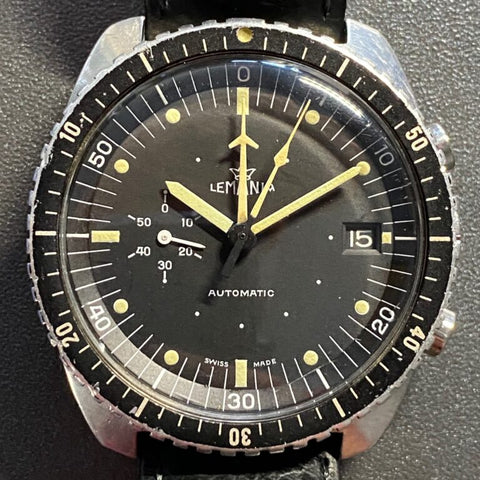
AF 12178

AF 11801

AF 11742

AF 11548

AF 118xx
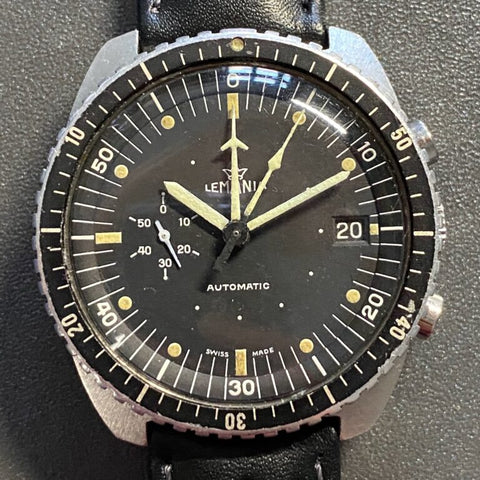
AF 11988

RAN 5100
For the research, I collected samples from the author's collection, a collection of fellow collectors, and a Lemania 5012 that was up for public auction online.
The collected samples were not used as sources of information if not all details were clear (so about 5 were excluded).
Please let us know if you have any additional samples available to help us gather more accurate information for our investigation.
With the exception of the Lemania 5100 for the Royal Australian Navy (RAN) (sourced by Paul Gavin of www.heuerworld.com), all of the Lemania 5012s listed below are in the hands of the author and can be guaranteed to exist and be authentic.
Air Force control number and movement number
The table below shows the Lemania Air Force control numbers (AF numbers) and the corresponding Lemania movement numbers.
I tried to find a pattern between the two numbers but couldn't.
The expectation that early Air Force control numbers would have early movement numbers tied to them was incorrect.
We found that because they were offered in lots, there were mixed movements and they were not necessarily paired with the original dials, casebacks or cases.
Also, when it is stamped, care must be taken to ensure that it is selected from a lot and stamped.
This was done solely to engrave all 800 casebacks, and it is unlikely that they were even aware of the numbers of the movements inside.

table 1
number
All movement numbers for the Lemania 5012s issued to the SAAF start with 0400.
The oldest number I found is AF 11984 with movement number #04006125, and the most recent is AF12108 with movement number #04007056.
Assuming that only 800 Lemania 5012s were issued, the difference between the movement numbers of the old and new watches is 931. What accounts for this difference?
There is no certainty as to how the Lemania numbering system worked, or whether it was sequential.
SAAF's prefix remains consistent at "0400", with the following four digits referring to the quantity of movements actually produced.
Also, it should not be forgotten that there was a four month period between the delivery of the first and second batches, which may be the reason for the difference.
Interestingly, the RAN (Royal Royal Australian Navy) version of this watch has the prefix "0401" and is fitted with a Lemania 5012 movement with a frequency of 21,600 vibrations per hour compared to the RAN 5100 movement with a frequency of 28,800 vibrations per hour.

#4006229
Lemania Cal. 5012 (21,600 vph).

#4015621
Lemania Cal. 5100 (28,800 vph).
Dial
The dial of the Lemania 5012 is finished with a medium black matte coating.
There are rectangular hour markers filled with luminous material at 6, 9, 12, and next to the date at 3. The remaining hour markers are round and filled with luminous material.
Between each hour marker are four thin white line minute markers that extend to a fixed inner bezel displaying the numbers 10 to 50 in ten minute increments.
This inner bezel sits within a recess in the Plexiglas and is held in place by the pressure of the compressed Plexiglas.
The date is displayed as a number from 1 to 31 in a frameless window at the 3 o'clock position.
The dates all use the same font.
The sub-seconds are located at 9 o'clock and are marked in 10 second increments.
Unlike many other manufacturers, Lemania does not surround the sub-seconds display with a circle.
Between the hour marker at 12 o'clock and the center of the dial, the brand name "Lemania" is printed with a "crown" logo above it.
The word "AUTOMATIC" is printed in the same position below the center of the dial, and the words "SWISS" and "MADE" are printed on the upper left and right sides of the rectangular hour marker at the 6 o'clock position on the edge of the dial, in front of the inner bezel.
Except for the prototype version, there are no dial variations.

prototype
Please note the following differences:
- "AUTOMATIC" position
- "SWISS MADE" is not printed
- Date brackets

SAAF dial final configuration (AF 12178).
needle
The hands on the Lemania 5012 are interesting.
The hand set consists of an hour hand, minute hand, chrono sweep seconds, an airplane-shaped central minute counter, and a sub-seconds hand.
The hand color is quite interesting because I have seen original issued sets with very different color combinations.
Table 1 shows the color combinations found.
The sub-seconds are always white.
On the originals the hour and minute hands have always been cream/yellow (AF 12108 is out of pattern and I am excluding it as I assume it was repainted).
The airplane-shaped hands for the sweep seconds and minutes are also of interest.
On the original, I've seen both solid white hands (presumably to distinguish the chrono function from the regular time display function) and hands that are the same cream/yellow as the hour and minute hands.
It is believed that this color change was implemented when the second batch was delivered.
Maybe the SAAF asked for some tweaking.
Using different colors for the time display and the chronograph function makes sense.
The sweeping seconds hand is perhaps unique to this watch.
The sweep seconds on the Omega 861 look the same when painted with luminous material, but whereas the Lemania 5012 has a solid end, the arrow-shaped hand on the Omega 861 has a small luminous triangle at the end.
The airplane-shaped hands are also different to traditional Omega hands, with the wings being wider and flared further back.
Lemania also used the same in several other watches with the same 5100-based movement.
And then the pilots appear.
I got in touch with a SAAF watchmaker who has been retired for 10 years and he told me it was common for pilots to request the tips of their chrono hands be painted in Oryx Helicopters yellow or bright red.
The watchmaker, who goes by the name of DH, still has his jar of yellow luminous paint on hand, but now has trouble getting the paint to the right viscosity, after all of the top-secret thinner that his chemists specially mixed in the late 1980s has evaporated.
Anything DH uses now dries too quickly and doesn't give the same uniform, light, powdery look that it once had.
According to DH, during maintenance periods, the hands of the watch were often replaced and the lume reapplied.
As a collector, it took some convincing that I wanted to keep the original dull yellow lume instead of the pure white or electric yellow used in the repaint.
The repaint turned out more yellow than the original cream/yellow.
The lume had a light, powdery consistency and covered the entire hand from end to end, leaving only a base and center that was coated with black powder.
Over time, some of the hands seem to have discoloured from the centre, with some showing very light brown oxidation near the centre.




Example of changing/repainting hands
It's important to keep in mind that the aging of luminous paint is influenced by a variety of factors.
The watches were placed at South Africa's two main air force bases: Waterkloof/Swartkops, which is hot and dry at about 1,500m above sea level, and Langebaan, which is humid at sea level.
Due to the very different geographical conditions of the two locations, the aging characteristics of the luminous paint are very different.
There is always a debate between original and repainted, but the Lemania 5012 is considered a rugged tool watch used by official pilots.
The Lemania 5012 was on a regular inspection schedule, just like any pilot-operated airplane.
If a pilot requested the chrono hands be painted bright red or Oryx Yellow, it was done with a purpose and would still be considered an Air Force original.
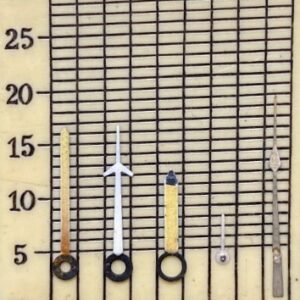

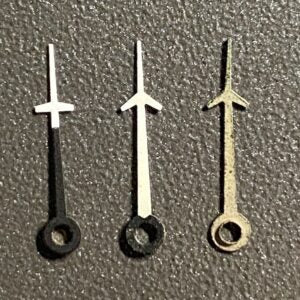

Sweep second hand
Case Back
Of the 800 issued, several currently in circulation appear to have had all or part of their Air Force control numbers intentionally obliterated.
I have personally never seen a Lemania 5012 without the Air Force control number (which has not been deliberately erased).
According to staff at the Military Store at the time, all watches were engraved as soon as they were delivered to the SAAF, so even if they were not issued to pilots there should be no unengraved watches in existence.
The pilots were apparently reluctant to return their watches, even though they were offered replacements.
It appears that some of the watches have had their Air Force control numbers erased for fear that they could be traced to pilots through issue records.
Having been in the South African Defence Force in the early 1990s, I understand the Defence Force’s system of state property and the horrors associated with state property being lost, stolen or damaged.
The engraving on the caseback was done using a pantograph system and appears to have been carried out using two different machines, or two different engraving heads.
The pantograph contained a plate with numbers on it, which translated larger movements by the operator through a geared arm into smaller movements on the caseback attached to the other end.
The engravings were applied to the top third of the flat area of the caseback or just above the center (except for AF 20488, which is engraved in the center).



AF 20488
Out of sequence

AF 11742
The markings are very faint

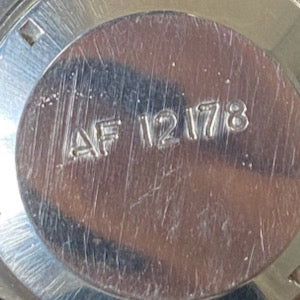
AF12178
Same font, but different engraving
Although it may appear that two very different fonts and plates are used, the same stencil may produce different results depending on the pressure applied by the operator and the age of the cutting head used.
The fonts differ from each other in two ways: one has a small font and deep engraving, the other has a large font and lighter engraving.
It is not known whether these two fonts are from the first or second batch, but as both batches were delivered to the SAAF within four months of each other, they are unlikely to be related.
The watch I was issued just 6 months (circa 1987) before I was issued my new Seiko 150 had deep markings in small font.
It is believed that after both lots were stamped, they were sent to a military store where they were consolidated in one place and then issued randomly.
Considering this, it also explains the lack of correlation between the timing of issue and the font of the Air Force control number.

The inside of all casebacks are engraved with the following:
- ACIER INOXYDABLE
- 11001
- 11015
Prototype 1 also had this marking.
exception
There are exceptions to everything.
So far, I've found only three exceptions to the norm, one of which is a prototype.
The difference lies in the outer bezel and the font of the number 4.
This point was first pointed out to me by a fellow SAAF Lemania 5012 collector, Eugene.
There appear to be two versions of this font, one with a pointed four and one with a flat four.
Prototypes were presented with the number 4 in flat font, but after SAAF decided on the final design and layout of Lemania 5012, the font for the number 4 appears to have been changed from a flat to a pointed font.
What's interesting is that the number 4 on the inner bezel and date wheel is always in a flat font.
In the three exceptions I found, the font on the outer bezel all matched the font on the inner bezel.
One of them, AF 20488, does not seem to follow the pattern of any of the others.
AF 20488 has the Air Force control number in the wrong order, engraved in a different font and in a different place than usual on the caseback, and the number 4 on the outer bezel is flat in font.
However, there are approximately 300 movements between #04006200 and #04007000, which fits into the SAAF issue order.
In all other comparisons, the AF 20488 is essentially identical to the other watches.
AF 20488 also shows no sign of its previous Air Force control number having been erased.
Usually, wherever the pantograph changes direction it leaves a slightly deep "hole" which makes it possible to see its mark.
Eventually, I was always able to find traces of the numbers that had been erased by the magnifying glass.

AF 20488
Bezel 4 font flat

AFxxx4
The font for the number 4 on the bezel is normal and pointed

prototype
Bezel 4 font flat
A SAAF Lemania 5012 with the original strap issued has yet to be found.
I've seen one on a black leather 20mm wide Hirsch strap (which is known to have been replaced) and I've also seen a few on a Seiko steel bracelet.
We suspect that the SAAF had purchased a spare Seiko bracelet for the next Seiko sports watch that was due to be issued, and replaced it with the last of the watches brought in for inspection.
Regarding the servicing of the Lemania 5012, I have heard that watches brought in for servicing were initially replaced.
The pilot did not receive his original watch, but a watch that had been purchased in advance for the servicing.
I am not sure how the Air Force control numbers were re-linked to the pilots, but in my experience there were likely rules and procedures for doing so.
I've heard that initially this was done to track parts usage, but pilots became upset about it, so when they allowed watchmakers to repair pilots' watches, they were told to keep the used parts they replaced so that repairs and parts usage could be audited.
As new Seikos were issued from the late 1980s onwards, the Lemania 5012s, now considered "old technology", were recalled, destroyed or discarded.
DH told me stories of destroying returned watches by hitting them with a hammer or crushing them in a vice.
He remembers a bucket full of destroyed cases destined for disposal.
We were also told the story of how the then-captain stormed into the workshop and ordered that all Lemania 5012 parts and spares be destroyed, both new and old.
DH followed orders and disposed of everything.
Any Lemania 5012s that had not yet been issued and were in stock were sold to SAAF ground personnel for R36, limited to one per person.
The image below is of a watch I purchased from one of the ground crew.
The buyer's own watch had stopped working a few days prior, and as the timing was right, he purchased the Lemania 5012. However, he only wore the watch a few times before replacing the battery, and then the Lemania 5012 sat in his bedside drawer for the next 30 years.

AF 12178
Purchased from SAAF ground crew (late 1980s).
Conclusion
I recently spoke to a SAAF chopper pilot from the 1980s who was extremely annoyed when he was refused permission to trade in his Lemania 5012 for a new SAAF Seiko Sports 100 when he left the SAAF in the late 1980s.
Looking back, it was a stroke of good fortune.
He also told me a story about a SAAF chef who had a Lemania 5012 and the pilots got angry.
The pilots believed that they had earned this magnificent watch by flying at extreme speeds and against high G-forces for the South African Air Force.
I also heard from my friend G that he bought a Lemania 5012 from the Brigadier in exchange for two bottles of brandy, and then drank the brandy together with the Brigadier.
Please understand that all information has been collected from SAAF pilots, store staff, ground crew, DH (SAAF watchmaker) and other collectors and has been edited and interpreted as best as possible.
If you have any information that contradicts or corroborates the content of this article, please feel free to contact us.
Thanks to Neil Herbert for his contribution.



